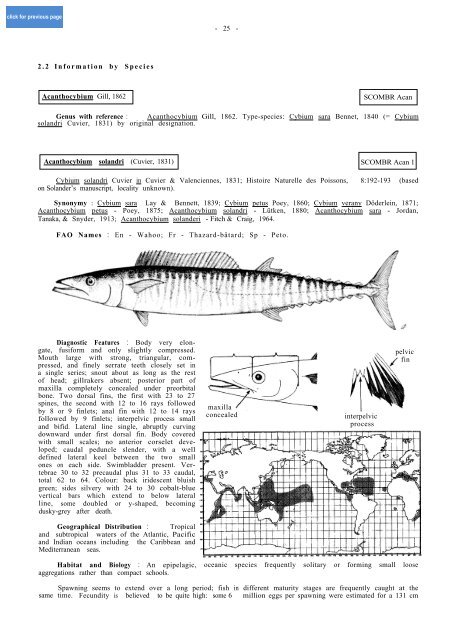FAO SPECIES CATALOGUE - si-pddr
FAO SPECIES CATALOGUE - si-pddr
FAO SPECIES CATALOGUE - si-pddr
You also want an ePaper? Increase the reach of your titles
YUMPU automatically turns print PDFs into web optimized ePapers that Google loves.
click for previous page<br />
2.2 Information by Species<br />
Acanthocybium Gill, 1862<br />
- 25 -<br />
Genus with reference : Acanthocybium Gill, 1862. Type-species: Cybium sara Bennet, 1840 (= Cybium<br />
solandri Cuvier, 1831) by original de<strong>si</strong>gnation.<br />
Acanthocybium solandri (Cuvier, 1831)<br />
Cybium solandri Cuvier in Cuvier & Valenciennes, 1831; Histoire Naturelle des Poissons, 8:192-193 (based<br />
on Solander’s manuscript, locality unknown).<br />
Synonymy : Cybium sara Lay & Bennett, 1839; Cybium petus Poey, 1860; Cybium verany Döderlein, 1871;<br />
Acanthocybium petus - Poey, 1875; Acanthocybium solandri - Lütken, 1880; Acanthocybium sara - Jordan,<br />
Tanaka, & Snyder, 1913; Acanthocybium solanderi - Fitch & Craig, 1964.<br />
<strong>FAO</strong> Names : En - Wahoo; Fr - Thazard-bâtard; Sp - Peto.<br />
Diagnostic Features : Body very elongate,<br />
fu<strong>si</strong>form and only slightly compressed.<br />
Mouth large with strong, triangular, compressed,<br />
and finely serrate teeth closely set in<br />
a <strong>si</strong>ngle series; snout about as long as the rest<br />
of head; gillrakers absent; posterior part of<br />
maxilla completely concealed under preorbital<br />
bone. Two dorsal fins, the first with 23 to 27<br />
spines, the second with 12 to 16 rays followed<br />
by 8 or 9 finlets; anal fin with 12 to 14 rays<br />
followed by 9 finlets; interpelvic process small<br />
and bifid. Lateral line <strong>si</strong>ngle, abruptly curving<br />
downward under first dorsal fin. Body covered<br />
with small scales; no anterior corselet developed;<br />
caudal peduncle slender, with a well<br />
defined lateral keel between the two small<br />
ones on each <strong>si</strong>de. Swimbladder present. Vertebrae<br />
30 to 32 precaudal plus 31 to 33 caudal,<br />
total 62 to 64. Colour: back iridescent bluish<br />
green; <strong>si</strong>des <strong>si</strong>lvery with 24 to 30 cobalt-blue<br />
vertical bars which extend to below lateral<br />
line, some doubled or y-shaped, becoming<br />
dusky-grey after death.<br />
Geographical Distribution : Tropical<br />
and subtropical waters of the Atlantic, Pacific<br />
and Indian oceans including the Caribbean and<br />
Mediterranean seas.<br />
maxilla<br />
concealed interpelvic<br />
process<br />
SCOMBR Acan<br />
SCOMBR Acan 1<br />
Habitat and Biology : An epipelagic, oceanic species frequently solitary or forming small loose<br />
aggregations rather than compact schools.<br />
Spawning seems to extend over a long period; fish in different maturity stages are frequently caught at the<br />
same time. Fecundity is believed to be quite high: some 6 million eggs per spawning were estimated for a 131 cm<br />
pelvic<br />
fin
















